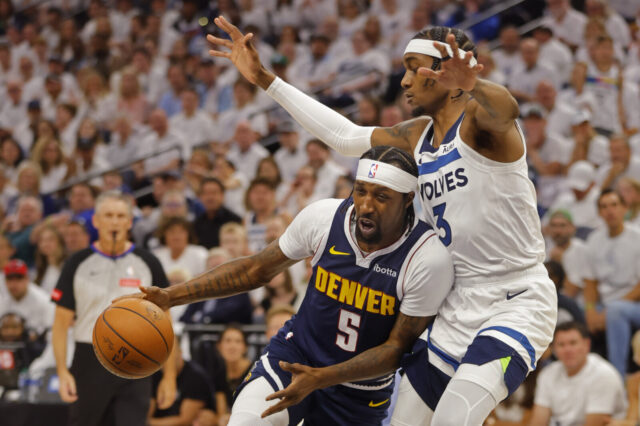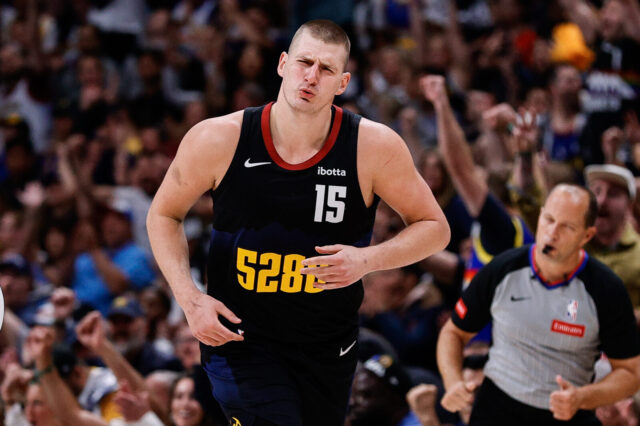The Denver Nuggets did not rest on their championship laurels during Thursday’s NBA Draft. They believe they got better.
Entering the playoffs in April, the 2023 NBA Draft wasn’t in the mind’s eye of any Denver Nuggets fan. At that time, the Nuggets had the 40th overall pick, and there was little expectation throughout April and May that the team would make the draft a priority. Then, on June 9th prior to Game 4 of the NBA Finals against the Miami Heat, the Nuggets executed the rare trade as a Finals participant, sending out a 2029 first round pick to the Oklahoma City Thunder and acquiring the 37th overall pick along with a 2024 first rounder and 2024 second rounder. Suddenly, the Nuggets had two draft picks at their disposal this year.
But that trade on June 9th wasn’t finalized, and in the end, it became a significant four-team trade between the Nuggets, Thunder, Indiana Pacers, and Los Angeles Lakers that re-routed picks in several directions. At the end of it, the Nuggets acquired three draft picks in the 2023 draft and kept that 2024 second rounder they acquired from OKC. The Nuggets acquired the 29th, 32nd, and 37th picks this year as well as a 2024 second round pick at the cost of the 40th pick and a 2029 first round pick. It’s a pretty solid deal that allows the Nuggets to add multiple cheap contributors sooner than 2029 when Nikola Jokić is likely not in his prime anymore.
From the picks Denver acquired this year, the Nuggets decided to emphasize shooting, off-ball movement, and high IQ basketball.
At 29th overall, the Nuggets added Julian Strawther, a shooter on the wing with a solid frame for the small forward position at 6’7″ with a 6’9″ wingspan. Strawther was nominated as a Julius Erving award finalist for the top college small forward in college basketball, averaging 15.2 points and 6.2 rebounds per game for the Gonzaga Bulldogs. Strawther shot 40.8% from three-point range this year and has shooting touch all over the court, including on floaters. Defense will be a struggle for him early on, but as he improves on that end, he becomes an interesting bench option for the Nuggets rotation in the coming years.
At 32nd overall, the Nuggets added Jalen Pickett, a thicker 6’4″ point guard with an abnormal game for the modern NBA. At Penn State, Pickett played like more of a forward than a guard at times as a post up player and isolation hunter. Pickett sought out mismatches and made them count, showcasing great touch around the rim and creativity as a scorer despite being a smaller guard attacking the paint. Pickett’s abnormal game extended to his playmaking for others and rebounding at the guard spot, ranking first in total assists and fifth in total rebounds in the Big Ten conference. Pickett is a throwback player in some ways, and the Nuggets are hoping his high level basketball IQ can help his game translate.
At 37th overall, the Nuggets added Hunter Tyson, a lanky 6’8″ forward out of Clemson with an elite outside shooting stroke. Tyson played five years at Clemson and ultimately became the top defensive rebounder in the ACC conference. His efficiency from all three levels as a scorer stood out, primarily a 40.5% three-point shot on a wide array of attempts. Tyson made threes from the corners, the wings, the top of the key, extended his range, and even hit shots off movement. His athleticism leaves something to be desired, but there’s a clear path to becoming a role player in the NBA if he can improve is strength/quickness with NBA conditioning.
The above three selections will join a championship winning roster. The starting five for the Nuggets, headlined by Nikola Jokić and Jamal Murray, remains entirely intact. Off the bench, rookies Christian Braun and Peyton Watson now become second year players, and Braun is likely to step into a more consistent bench role. Watson is a wildcard but has plenty of potential for impact. The only other two players on the bench beyond the two young guys are Vlatko Čančar and Zeke Nnaji. Čančar is likely to be back on a cheap contract with potential to make an impact next year. Nnaji is in the final year of his rookie deal, and the Nuggets have to decide whether they want to retain the 6’9″ big man or find a more consistent option.
The Nuggets have six unrestricted free agents and two restricted free agents (two-way contracts) that may or may not be back with the Nuggets next year.
Bruce Brown is Denver’s biggest priority and remains an important domino in Denver’s off-season plans. While both Pickett and Strawther are interesting young players, neither brings the blend of defense, athleticism, and aggressiveness that Brown brought to Denver’s playoff rotation. If Brown returns on a cheaper than market value contract, the Nuggets bench is relatively solidified. If Brown departs for a larger contract in free agency, the Nuggets will likely piecemeal together a backup point guard rotation with a different veteran.
Jeff Green hopes to be back in a Nuggets uniform after his contract with the Nuggets expired this off-season. Green’s veteran leadership and steadying presence helped the Nuggets navigate the regular season and playoffs relatively smoothly, and Green can still play a little bit as a bench forward/big man in a rotation role.
DeAndre Jordan and Ish Smith rarely played by the time the playoffs rolled around, but their veteran leadership added to Green’s to form a coalition of leaders. The Nuggets raved about the combined voices of Green, Jordan, and Smith throughout the season, and if there’s room to bring back those guys, Denver will certainly consider it.
https://www.youtube.com/watch?v=uROf-tkgis0
Reggie Jackson and Thomas Bryant were two trade deadline acquisitions during the middle of the season that didn’t have time to pan out. The Nuggets still believe in the talent of both guys, but finding roster spots and rotation minutes for either player could prove difficult. The Nuggets bench lineups were a drag during the regular season last year, and the combination of Jackson and Bryant hindered that group rather than helped. Perhaps things could be different after an off-season and training camp of integration.
Finally, Collin Gillespie and Jack White are the two restricted free agents. Both would seemingly love to get full-time contracts with the Nuggets this year, but the unfortunate reality is that Denver’s roster can only hold 15 full-time contracts. By drafting Strawther in the first round, the Nuggets are slated to have 10 full-time contracts for the 2023-24 season before returning any free agents. In addition, both Pickett and Tyson from this rookie class would surely hope for full-time contracts as well. Either some of these young guys are going to have to take a two-way contract instead of a full-time deal, or Gillespie/White might not be back next year.
The Nuggets will figure out what needs to happen with the rest of their end-of-bench roster. Bruce Brown is a separate matter and supersedes all of this, and his return could shift things in an interesting way for Denver.
But the most important development for the Nuggets from Thursday night’s draft festivities was the mass addition of offensive role players. Julian Strawther and Hunter Tyson represent high level outside shooters, both 6’7″ or taller, that can hit important shots for the Nuggets in both spot-up and on-the-move situations. Three-point shooting is always a great way to bolster a bench unit, and if the Nuggets can continue to add versatile shooters, they can always find lineups in the future that can space the floor for their primary actions.
Jokić and Murray each turned 28 and 26 respectively this last February. They are squarely in their primes as offensive creators, and Murray might even have another level to reach as he gets further and further away from that ACL tear. The Nuggets dynamic duo just dropped dueling 30-point triple-doubles in the NBA Finals on the road. They don’t need a ton of help to continue generating great offense for the team, but one way to make their lives easier is to constantly add three-point shooters that move well off the ball. Strawther and Tyson both represent that skill set in slightly different ways at different positions, and if either of them becomes rotation caliber, it’s another weapon to assist the Jokić-Murray two-man dance.
Pickett is a little bit different only because he’s so unique. He’s a bigger point guard that operates in a similar way to Murray as an interior scorer, often posting up smaller players or getting his defender on his back to generate space for shots and passes. Pickett’s still learning and developing, but his unorthodox style pushed him down draft boards as a non-traditional playmaking guard with limited burst that other teams would struggle to use. Pickett might also struggle to fit into Denver’s system, but there’s at least a world where Jokić identifies the skills of an unorthodox player and helps bring out the best of him. Pickett will have some time to figure it out, but if he does, there may be some hidden value there that other teams couldn’t take a chance on.
Right now, the Nuggets are trying to figure out the best way to win a championship. With the rules of the new CBA making it more difficult to be an expensive team, the Nuggets are one of the teams that’s acted the quickest to add as many cheap rookie contracts to an expensive roster as possible. We still don’t know the details of Pickett and Tyson, but the Nuggets have now drafted six players in the 21 to 46 range across the first two seasons of Calvin Booth’s tenure, including Ismael Kamagate who will remain overseas next year. Booth has a clear plan for financially handling Denver’s roster featuring three max contracts between Jokić, Murray, and Michael Porter Jr. going forward: add as many cheap, role players with versatile skillsets around that trio as possible.
(On a separate note: there’s a bit more pressure on Porter heading into next season as he hopes to get healthier and improve his game. The Nuggets just added another two players at the forward spots, joining Christian Braun and Peyton Watson as players younger than Porter that can contribute in a variety of ways. The recourse for improvement in Denver if things don’t go as well next year is probably to break up Porter’s max contract into multiple smaller role player contracts.)
Picking and choosing which veterans come back will be important for the Nuggets. They clearly need to add some size to their frontcourt again and could use a semi-permanent backup center option. If Brown isn’t back, the Nuggets still need to add a guard, and likely a guard that can run the team in the minutes Murray doesn’t play.
The Nuggets will likely enter the 2023-24 regular season with a different goal in mind than the previous regular season. The Nuggets still need to win a championship, but if at least five of Denver’s 18 players on their roster are first or second year players, development and patience will have to be a factor. Even if the younger players are more ready than other younger players…they’re still young and need time. Denver, and more specifically Malone, Jokić, and Murray, will have to give those players enough time and patience to become versions of themselves that the Nuggets can use in the playoffs. That likely means an underwhelming record compared to Denver’s reputation and continuity.
Can Strawther, Pickett, and Tyson help aid Denver in their quest for a second championship in a row? Time will tell.



